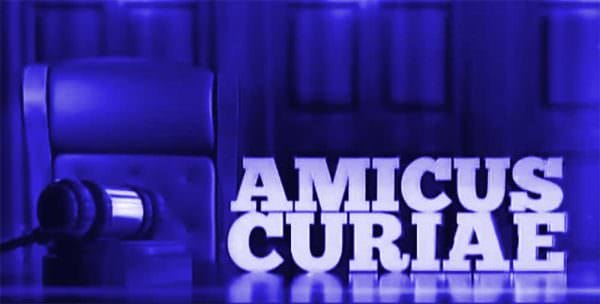
U.S.A. –-(AmmoLand.com)- Described as the first significant Second Amendment case to be heard in a decade, New York Rifle and Pistol Association v. Corlett, has, as expected, engendered a large number of amicus briefs.
Amicus (friend of the court) briefs are submitted by parties who wish to bring facts and arguments before the court, which might not otherwise be noticed by the court.
This is an important function. It has the potential to prevent absurdities such as happened in the first direct challenge to a federal law using the Second Amendment, U.S. v. Miller, 1939. That case challenged the National Firearms Act of 1934. It was sent back to the District Court, in part, because the Court ruled no one had presented evidence that short-barreled shotguns were useful to a militia.
In the New York case, 52 amicus briefs have been accepted by the Supreme Court. Amicus briefs are required to be submitted in a rigid format, with strict printing requirements, on a fixed timeline. This author was contacted to contribute to one of the amicus briefs. Unfortunately, events prevented such a contribution.
What appears to be the last amicus brief accepted was from the Black Attorneys of Legal Aid of New York City.
As with most amicus briefs accepted by the Supreme Court, it is well written and argued. The bar for acceptance is high. This brief spotlights the enormous human costs of the routine violation of Second Amendment rights by the State of New York.
Those who have been involved in the fight to restore Second Amendment rights are familiar with those costs: Innocent lives destroyed, lives lost, years in prison, property lost, children lost, marriages destroyed, all because governments have been unwilling to recognize the exercise of Second Amendment rights, and courts have been unwilling to enforce those rights. Here is the summary of the amicus brief. From the supremecourt.gov:
SUMMARY OF ARGUMENT
The incorporated Second Amendment affords the people “the right to keep and bear arms.” U.S. Const. amends. II, XIV McDonald v. City of Chicago, 561 U.S.742 (2010)District of Columbia v. Heller, 554 U.S. 570 (2008). Despite the clear text and this Court’s precedent, New York’s licensing regime does the opposite. It deprives everyone of that right, only returning it to those select few who manage to first secure a firearm license from the police. For everyone else, possession of a firearm is effectively a “violent felony,” punishable by 3.5 to 15 years in prison. N.Y. Penal Law §§ 265.03; 70.02(1)(b). New York’s licensing requirements criminalize the exercise of the fundamental Second Amendment right with rare exception.
As a result, each year, we represent hundreds of indigent people whom New York criminally charges for exercising their right to keep and bear arms. For our clients, New York’s licensing regime renders the Second Amendment a legal fiction. Worse, virtually all our clients whom New York prosecutes for exercising their Second Amendment right are Black or Hispanic. And that is no accident. New York enacted its firearm licensing requirements to criminalize gun ownership by racial and ethnic minorities. That remains the effect of its enforcement by police and prosecutors today.
The consequences for our clients are brutal. New York police have stopped, questioned, and frisked our clients on the streets. They have invaded our clients’ homes with guns drawn, terrifying them, their families, and their children. They have forcibly removed our clients from their homes and communities and abandoned them in dirty and violent jails and prisons for days, weeks, months, and years. They have deprived our clients of their jobs, children, livelihoods, and ability to live in this country. And they have branded our clients as “criminals” and “violent felons” for life. They have done all of this because our clients exercised a constitutional right.
Therefore, we ask this Court to answer the question presented in a way that will protect the Second Amendment for all the people: by holding that Petitioners’ license denials violated the Second Amendment because New York’s licensing regime is unconstitutional.
This correspondent has a minor issue with the argument in the second paragraph.
New York enacted its firearm licensing requirements to criminalize gun ownership by racial and ethnic minorities.
The sentence is true. It does not go far enough. A primary purpose of the New York scheme was to prevent people from fighting back against organized crime in New York City. The proponent of the scheme, Big Tim Sullivan, was one of the leaders of the Tammany Hall Gang. Extortion does not work as well if your victims are armed.
Over the decades, this correspondent has seen innocent people arrested, jailed, sent to prison, their property confiscated, their lives ruined, their children taken, their careers destroyed, all for exercising their Second Amendment rights. A fair number have been killed.
No system is perfect. The Constitutional system of ordered liberty with checks and balances to limit governmental power has been shown to be the best implemented thus far. It allows for continual improvement.
Much progress has been made in restoring the legal exercise of Second Amendment rights. Much more needs to be done.
About Dean Weingarten:
Dean Weingarten has been a peace officer, a military officer, was on the University of Wisconsin Pistol Team for four years, and was first certified to teach firearms safety in 1973. He taught the Arizona concealed carry course for fifteen years until the goal of Constitutional Carry was attained. He has degrees in meteorology and mining engineering, and retired from the Department of Defense after a 30 year career in Army Research, Development, Testing, and Evaluation.

The post New York Rifle & Pistol Association v. Corlett, BALA Brief appeared first on AmmoLand.com.
from https://ift.tt/3zRPalp
via IFTTT

No comments:
Post a Comment